This web page contains the logs of the second leg of a 31 day sailing trip that I took with S/Y Thetis from Greece to Gibraltar. The logs cover a period of 9 days of sailing from Reggio Calabria in Italy to Menorca (Mahon) in Spain via the islands of Ustica and Cagliari (in Sardinia Italy).
The logs are illustrated with photographs and maps. They also include some historical and geographical descriptions of the places visited as well as several links to other related web sites.

Wednesday October 6, 2004 Day 11
We were woken up by the arrival of a British yacht with a large crew. They were very noisy and uncoordinated while mooring next to Thetis. They said that they had also come from Cephallonia but they were not sure… They asked if we had a recent weather forecast. I told them, after connecting with the GPRS/Internet, that for the Tyrrhenian Sea NE winds are expected of force 2-3. They also asked about tides. We told them that for going N in the Strait of Messina the morning hours were good. Before we knew it they cast off and left. I found all of this very suspicious and hope that our paths do not cross again.
We also cast off, but first we went to the fuel dock, which opens at 0700. We refilled our tank with 27 L, that is all we had burned since Cephallonia.
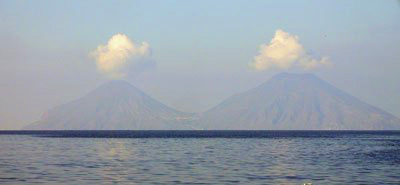
We departed Reggio Calabria at 0735. Unlike my previous passage through the Messina Strait, which was hair raising, this time we had absolutely no problems. As soon as we were out of the straits we set course 281° for the S tip of Vulcano island. The wind did not cooperate and we kept on motoring over the mirror-like sea. We passed the S tips of Vulcano, Lipari, and Salina islands. This last island presented us with with the dramatic profile of its double conical peaks covered by clouds. On we went past Filicudi, at a distance, and Alicudi, to the open water and a course of 384° to our destination, Ustica. All these islands are known as the Aeolian islands and are subject to strong winds.
After a lovely sunset, which we celebrated with ouzo and ice cubes, a luxury to be indulged as a compensation for the long hours of motoring, we made dinner. We still had some of the endless veal roast and a few oven potatoes, and we also made some rice.
At 2100 we started our watches and I took the first 3 hours.
Thursday October 7, 2004 Day 12
Manos relieved me at midnight and I went to sleep until 0300 when it was my turn again. The first thing I noticed was that the red navigational light was out. I just turned the regular navigation lights off and turned on the tricolor mast light instead. This is not regulation correct because the tricolor is only allowed when sailing and we were motoring but it could not be helped. Other than that, it was a totally uneventful watch. I put on the headphones and listened to music from my iBook computer. At 0500 I called Manos but he was sound asleep. Since I was not sleepy and was actually enjoying the peaceful early hours I let him sleep. This state of relative bliss was interrupted by traffic. Until now we had been all alone. Now 3 large ferries crossed our path, within a couple of miles to our stern, and I had to take evasive action to avoid a slow moving fishing boat. Ustica declared itself in the darkness of the early morning with its strong lighthouse beam that could awaken a tired mariner. Finally we arrived in Ustica [38° 42.5' N 13° 11.8' E] at 0715. Distance from Reggio: 122.8 M.
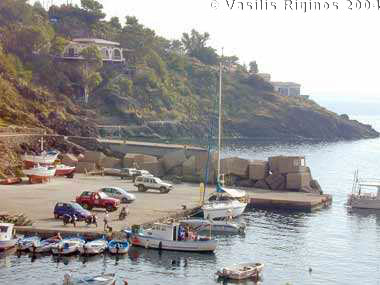
We moored side-to, without any problem, taking the space of two boats almost in the exact spot Thetis used 8 years ago. We were certain that we did not deprive anyone as traffic was bound to be only a few fishing row-boats and inflatables catering to the diving tourism that abounds here and these can moor anywhere.
After putting the boat in order we reconnoitered the fuel station which was on the opposite side of the harbor. We discovered that the place was closed on Thursdays and Tuesdays and is open from 0730 to 1030 the rest of the days. This means that we will need to wait until tomorrow, Friday, to replenish the fuel we spent after the 20 hours of motoring. We continued uphill towards the village center which was shining amphitheatrically in the morning rising sun. Already in the village square, shaded by huge trees, was movement and freshly fished Mediterranean varieties of fish were presented for sale. We bought postcards, our first, wandered looking for fresh bread and fruits and then sat for coffee in the square next to a group of retired Italians engaged in serious conversation and gesturing heavily. It could have been on any Greek island. We wrote our cards and posted them before descending back to the boat.
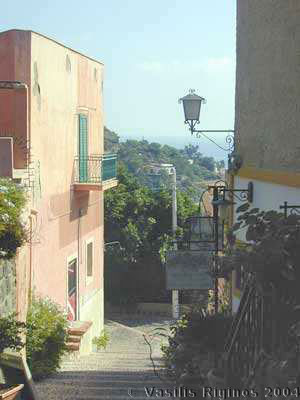
Near Thetis, tourists were preparing for scuba diving among the many grottoes formed by lava a long time ago offering many varieties of fish and coral. The place is an officially protected marine park. We got fresh weather forecasts. They showed similar conditions to yesterday’s and today’s until Saturday but with a deterioration starting on Sunday. Based on these reports we decided not to stay here for 2 days as we were planning but to push on for Sardinia. We calculated that if we were to depart tomorrow at 2 AM we would be at Cagliari by early afternoon on Saturday. As far as fuel went, I calculated that we will still have enough, with a comfortable margin, even if we have to motor all the way. After these momentous decisions we had a relaxed lunch again, with the local charcuterie and a large choriatiki (Greek salad) and took our midday siesta.
After we got up and had a restorative cup of coffee it was time for some maintenance work. First was the easy task, replacing the burned bulb of the red navigation light. Next was time to change the oil and fuel filters of the engine. But I will let Manos describe the experience:
Time had come for some engine maintenance of Thetis. Vasilis felt we could not further avoid this horrendous experience. So he prepared the operating room, gave a quick lesson to the able but ignorant-on engines crew and dived into the engine hold. First the engine oil was pumped out carefully to avoid spillage and was put in the specially kept old container where it had come from. Then the oil filter was removed with a special tool and a new one took its place. Plastic bags were all over the place receiving papers and engine parts full of the blood of the engine. Then we had a transfusion of new oil and cleaned odd spots around the sleeping engine. We took its pressure to see the levels of its oil and added enough to reach its correct levels.
Then came the most delicate job of replacing the two fuel filters. The first was in a difficult to access place. Vasilis on his knees got deeper in the hold, he raised his right hand and ordered: screwdriver, hammer. His able assistant behind him had all the material and tools ready and quickly handed them to him. The casing of the filter was opened and the filter emerged relatively clean in spite of 150 hours of engine operation. Then was the time for the pre-filter. That was harder as it was surrounded by different tubing. With some light spillage it emerged, much dirtier, and was replaced without serious problem. Finally the operation of pumping out the air (bleeding the lines) that had crept in the system had to be performed. That involved using a small pump on the engine and seeing that petrol come out instead of air. The engine would be started and if it did not fall back into sleep coughing terribly, it would mean everything was alright. The same operation was repeated several times. The engine kept reacting the same way: coughing. Time was passing. Throbs of sweat were forming on the frustrated chief. The able assistant had no clue of how he could help. At some instant he noticed something shining under the pre-filter. “I think there is a leak here” he said. Sure enough there was and the chief engaged to reassemble the filter he had replaced about half an hour ago with petrol flowing out profusely. Then again the pumping operations and testing of the engine. Half an hour more passed with great frustration in the chief’s face but determination to finish this. Sure enough, at some point the engine, after an initial throb started humming happily, coming out of its deep sleep. The smile came back on the chief and the able assistant. But it was not over. Lots of leaked petrol had to be sponged out with rolls of kitchen paper and the engine cleaned. Three hours had passed in romantic Ustica, with activities which are all part of owning and operating a boat. “Young man, after several trips like this and careful observation you may be able to do the same thing one day” said the relieved chief to the able assistant.
The reward? A shower in the closet-like 60 by 60 cm toilet/shower room of Thetis and a nice dinner at the Restorantino, half way up the steps to the village, with shrimp, lentil soup, grilled tuna steaks, and a bottle of white Sicilian wine. We returned to the boat by 2100 hours and went straight to bed to get up by 0100 to depart from lovely but undiscovered Ustica.
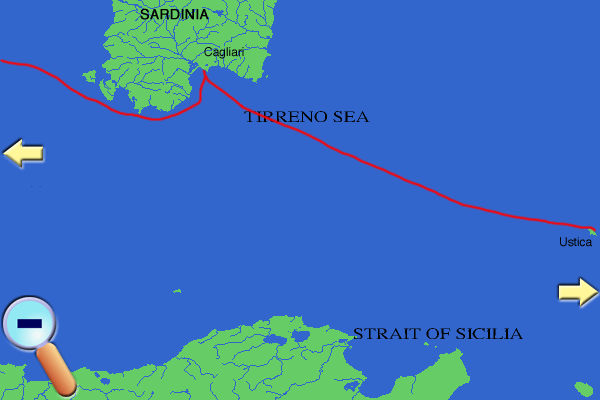
Friday October 8, 2004 Day 13
We woke up at 1 AM and prepared for departure. By 0150 we were off. We had some difficulty clearing the narrow space in the harbor without getting entangled in the many anchor lines of the adjacent small boats. It was a nice calm night. The wind was just 4-7 knots from the SSE. The engine was working well. The strong light-house was saying goodbye to us just as it said hello 18 hours ago. I took the first watch. I opened 30% of the headsail and motor-sailed at a good 6.2 knots. At 0840, after I woke up, Manos having already taken the second watch, the wind had increased to 10-14 knots S. We raised the mainsail, opened all of the genoa, and turned off the engine. Together with the wind however, came an increase of the waves so we started rolling. Later in the morning the wind increased further and we took a reef. We also reduced the headsail to 50%.
For lunch, I wanted to make an omelet. I broke the eggs into a soup plate but as I was getting ready to beat them a large wave upset the whole system, spilling the raw eggs into the cabin floor, the rug, and Thetis’ sparkling new galley stove. A royal mess! Cleaning it was really fun! Instead of the advertised omelets we settled for cold cuts, bread, and cheese. At least these were not messy.
In the early afternoon the wind was reaching 29 knots and we took in a second reef and reduced the headsail to just 10%. Now we were moving at the reduced speed of only 6 knots but all of us and especially Yiakoumis, the autopilot, were much more comfortable. The barometer fell to 1019 mB from the 1025 of two days ago. Three helicopters passed low over us. Other then that there was no traffic. We went on.
In the evening, I had to strap myself to the galley in order to cut the remaining veal roast into cubes which I warmed in their sauce. I then made some rice into which I mixed the cubes. It was very tasty but Manos did not feel like eating very much. He took the first watch; 9 to 12, and I went to bed.
Saturday October 9, 2004 Day 14
When Manos woke me up for my watch the wind was down a bit and we were making only 5 knots. Nevertheless I kept the reduced sail arrangement and just listened to music on the CD player. Later during Manos’ second watch the wind went down further to 7-10 knots S and he started the engine but kept the sails as they were. Around 0600, in my watch, the wind veered to SW and I rolled in the headsail and increased the engine’s RPM. By that time Capo Carbonara, the SE tip of Sardinia, was in sight.
We arrived in Cagliari [39° 12.7' N 9° 06.8' E] at 1150, much earlier that our estimate. We had come 181.6 M from Ustica. The situation in the main harbor had changed since Thetis’ last visit in October 1996. Now a small charter company had reserved most of the free quay and there were very few places to moor. Unlike last time, we had to anchor and moor stern-to despite the fact that Heikell advises that the holding is not reliable. We deployed the passarella, covered the mainsail, put up the tent, and went ashore.
It was much warmer in the port than out at sea. We decided to explore and walked less than 200 meters before we were in the part of the city with narrow streets and laundry hanging. We had indeed “parked” downtown. This part of town is separated from the sea by a nice promenade and beautiful buildings with shops and cafés under arched walkways, facing the waterfront.
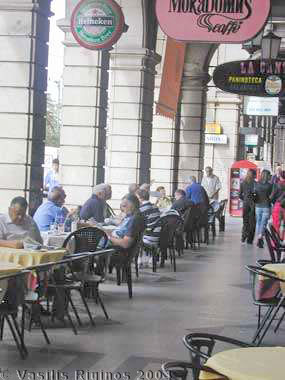
Manos had two priorities: get a Herald Tribune and wash his clothes. I too wanted to do some laundry. We set out to first get the paper and then ask about a laundromat. To Manos’ delight he found his newspaper right away. We also did find a laundromat which we ascertained will be open tomorrow Sunday. Pleased with ourselves we sat in a café under the arched walkway and had a beer and a snack. We then went back to Thetis for a much needed siesta.
In the late afternoon I was determined to replenish our fuel. I loaded the two empty jerry cans onto the little cart that I have for such occasions and carted them to the gas station about 300 m away. After filling them and returning to Thetis, Manos helped me siphon from them to the main tank, which we filled. A second trip to the gas station completed the job. Now both tank and cans were full. All together we got 75 L for 81 €.
After this task, I had a hot shower, changed clothes and rewarded the skipper and the faithful crew with a glass of ouzo. Later in the evening we went to eat at the Corallo restaurant which advertised itself as having “Cuccina Sardi tipica.” We were disappointed as nothing special or local was offered, just the normal Italian fare. The only atypical thing were the waitresses, they were all pretty Chinese girls. The meal was followed by a brief walk in the full of young people Saturday night Cagliari. We were too tired for anything else and decided to go to bed early and look for something different to do on Sunday.
Sunday October 10, 2004 Day 15
Sunday was how Sundays should be, late rising and reading in bed. We gave ourselves this luxury before breakfast. I connected the computer to the internet and paid some bills. I then took out the charts for the Balearics, the Spanish coast, and the Strait of Gibraltar.
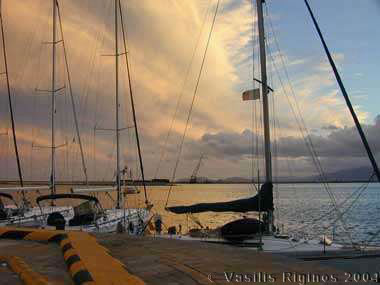
We then gathered our laundry and off we went to the laundromat. We had to sacrifice 5 € before we could figure out how the machines worked. We received advice from a big African man who was also doing his washing and who spoke decent English. Between washing and drying we returned to a café from where Manos obtained his Herald Tribune. While enjoying our morning espresso a huge religious procession occupied the coastal road in front of us. We were not sure of the occasion but were surprised to see so many different frocks and colors signifying differences in Catholic orders. There was also an order with hooded white robes following a large crucifix. It looked like Mississippi in the 1930s. We left rather puzzled but no more religious.
By the time we returned to Thetis, proudly carrying our clean laundry, it was almost noon. A strong WNW wind had developed gusting to over 30 knots. It was a cross wind and was pushing Thetis against the charter boat to her left. I will let Manos describe the situation:
A man appeared with his wife, obviously concerned about the state of the charter boats and was upset that we had moved near them, which was designated private (you damn Greeks cant you read?). Our efforts to adjust various ropes made things worse and brought our bow closer to the other boats. Our stern was in danger of scraping on the docks and we kept it off with fenders, which was a temporary solution. The Italian continued to be upset, but lifted no finger to help and was indicating we had to do something else. His wife was staying in the car feeling secondary to her husband’s boats. A family which had come to show the kids the pretty boats soon left to avoid any profanity that might have come out of the Italian. Thetis’ crew was going around waiting for orders. The skipper was calm and was reviewing the situation. Finally he decided to perform a delicate operation and turned the bow of the boat to the wind, mooring Thetis side-to. This required pulling one side of the bow on a long rope while letting the anchor slowly out from the other. It took 4 lines, the windlass, and 2 winches. We needed to do that in many steps to avoid scraping the stern on the pier as the boat was turning, before the side of the boat actually rested on the big rubber fenders that were on the cement pier. About an hour later everything was in place and the boat was safe without touching the pretty charter boats. The Italian had gone while we were struggling. Thank God that the anchor held, in a port which is known to be bad for anchoring. The skipper was congratulated for a handsome maneuver in difficult circumstances. This is how we spent our Sunday afternoon with little energy to do anything else but a quick lunch to be followed by siesta.
We looked at the weather. It seems that the frontal system that was over the Balearics a few days ago and was supposed to be over Sardinia tomorrow has come today and is already moving to the E. We may actually be able to leave tomorrow evening but we will need to see how the front will move by tomorrow.
When the night came we went to another restaurant, the Dal Conte, with a better choice and we had both primi and secondi piati along with a nice Sardinian red. All else was forgotten except the decision whether to leave or not the next day as there were ominous weather reports around us. The decision was postponed for the next morning.
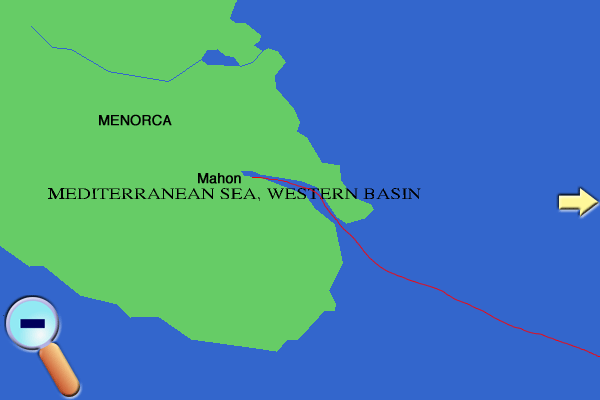
Monday October 11, 2004 Day 16
After one more night of uninterrupted luxurious sleep, we looked at the weather. It was not good but it was improving. It looked as if it will deteriorate here further but it will improve along our way to Menorca.
We did some chores in town and visited a marvelous shop where we stocked up again on bresaola, local cheese, some milk for the hot chocolate the crew likes (have to keep them happy) and fresh bread. We also bought a small chicken (the skipper likes) and fruits. We returned to the boat where the skipper immediately proceeded to cook the chicken with wine, fresh tomato and herbs, in anticipation of rough weather in front of us. In the meantime, Manos prepared a nice spread for lunch which we ate in the cockpit.
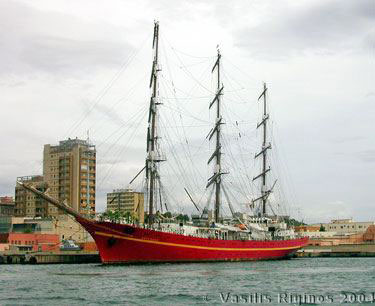
We pulled up our anchor and departed from Cagliari at 1400. As we were saying goodbye to the port we took pictures of a huge red hulled 3-masted Ukrainian navy clipper that had just arrived. Outside the harbor, the sea was a little rough but the wind was only 15-20 knots from the WSW. We motor-sailed for a short period, doing over 6 knots, but the wind was not cooperating.
After we passed Capo Pula, the head wind increased and we were slowed down. This along with the largish choppy waves and the contrary current reduced our speed to less than 4 knots. I warmed the chicken and had my supper but Manos did not eat, just in case. After eating I took the first watch.
After rounding Capo Spantivente we met with lots of traffic. I had to take evasive action several times. There was thunderstorm activity, most to the S, with lots of distant lightning. Near Capo Teulada, the SW point of Sardinia, a large ship was overtaking us on a collision course. I suppose either they were not looking or Thetis was invisible. I had to make a 90° turn, but even so the ship moved very slowly and came as close to us as half a mile. She took forever to overtake us. By that time we were way off our course and uncomfortably close to the land. We finally cleared both the ship and the cape. We turned to the left and set our course to 287° heading straight for Mahon the capital of Menorca. Alas, instead of the relief that I was hoping for, the wind also veered to WNW and we continued to have a head wind of 14-18 knots without any improvement to our miserable speed. The only good thing was that the sky ahead of us was clear.
Tuesday October 12, 2004 Day 17
Manos relieved me at midnight and I relieved him at 0245. During this time there was no appreciable improvement on our situation. 14-18 knot WNW wind, large choppy waves, and current, all against our 287° course. Our speed over ground, as measured by the GPS, did not exceed 4 knots. We just plodded ahead. I listened to music on the CD player. Manos relieved me again at 0500.
When I got up from bed at 0700 our situation had improved. The waves were smaller, the head wind down to 8-12 knots now from the WSW, and no current. Our boat speed increased to 5.5 knots. With this we may even get to Mahon. After sunrise, the sun was shining in a clear sky.
Later I repaired the broken bracket of the old depth sounder. I also re-glued the letters onto the horseshoe buoys.
Before lunch we transferred 2 jerry cans of fuel to the tank which, because we were motoring with higher than usual RPM (2400 instead of 2200), was now only ⅓ full. We were making decent progress. With the wind more favorable we opened about 20% of the head sail. This allowed us to reduce the RPM.
In the evening, after spending some time with the computer, Manos did not feel very well and for the second night he did not eat any of the chicken. I, however, did eat it along with a glass of wine. I was very hungry. Manos cooked an eggplant in the oven. He let it cool inside the oven and plans to make it into spread tomorrow. We could see distant thunderstorms.

Wednesday October 13, 2004 Day 18
It is 0230 during my watch. We are moving nicely under power, no sails, in a flat sea with a 5-8 knot N breeze making 5.5 knots. We are just 74 M now from Mahon. It is a clear night and the stars above are brilliant but we are almost completely surrounded by low clouds and distant lightning flashes. It is very eerie to be smoothly gliding on the glassy water on such a clear night and be continuously illuminated by large flashes and yet hear no sound of thunder. Here we are a tiny boat floating in this vastness with no land in sight. The combination of wonder, aesthetic delight, and apprehension is almost overwhelming.
At 0300 I was relieved by Manos. Before going to sleep I told him to be very careful about the thunderstorms and to wake me up if anything happened. He did wake me a few minutes before 0500. A large thunderstorm had snuck up on us. For the next hair-raising 45 minutes we kept changing our course and adjusting our speed to avoid the thunderstorm which was now very near. Thanks to the radar we avoided it and a few others except for one’s edge. There were thunderbolts and strikes all around us. And this time we could hear them. It was like a video game steering the boat so that she could sneak between the storms and avoid them, a challenging game considering the high stakes. After this critical time Manos went to bed but the game was not over.
Afraid of a thunder strike, I took the spare portable GPS to put it in the oven, which acts as a Faraday cage, thus protecting it from the enormous electric field. I had forgotten, however, that Manos had left a cooked eggplant in the oven and I almost put the GPS on the eggplant. For the next hour I kept on dodging more thunderstorms. As I am writing this, I am listening to Beethoven’s 5th Symphony on the earphones. It is very compatible with the grandeur of the storms but sometimes I am having difficulty distinguishing the tympani from the thunders.
Later, after I roused Manos, we transferred 2 more jerry cans of fuel to the main tank, which was about ¼ full. With this unsettled weather I felt that we should have a full tank and not to be forced to perform the fuel transfusion in possibly rougher seas later. Indeed, the wind soon increased to 15-20 knots NNW and so did the wave height. On we went all morning. At least the sky had cleared.
As we inched our way closer to Mahon more and more waves developed, all against us, and slowed us down. Finally after 1800 we entered the fabulous natural port of Mahon in Minorca [39° 52' N 4° 18.5' E]. We slowly made our way into the deep fjord-like port, full of castles from the Napoleonic wars, trying to figure out where to berth. Following the directions of the 2003-2004 Mediterranean Almanac we approached the “public” area but all the empty berths that we saw had a “Reservato” sign. We asked some yachtsmen but they were not too helpful. We tried hailing the Menorca Marina on the VHF channel 9 but there was no response. We reached the marina and moored on an empty pontoon berth and tied down between two lovely sailing boats over 50'. It was 1900 and we had traveled 245.2 M from Cagliari.
After we secured the boat, we walked ashore and discovered the facilities of the marina, although there was no one there to talk to, took showers and, happy to be on land, we walked along the waterfront. It was rather attractive. We entered a nearby restaurant, the Mason dela Puerto. It turned out to be an excellent choice. We had a tuna appetizer which was followed with bacalao (cod) and wild boar dishes and a great Rioja wine. We were in Spain, a new land, and ready to take a day off to explore and give a rest to the engine and our bodies. Satisfied but tired we walked back to Thetis for a much needed sleep.
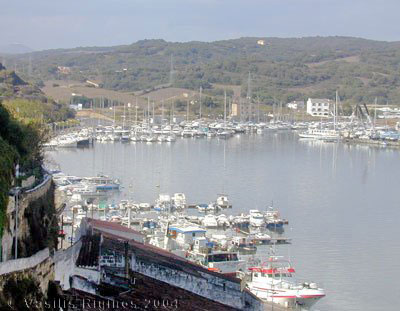
Thursday October 14, 2004 Day 19
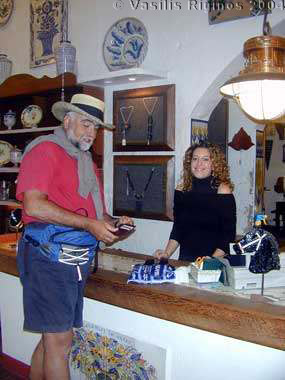
We did sleep, deeply and uninterrupted. After coffee, checking in to the marina (73 €), connecting the charger to the shore AC power, checking e-mail and weather we set out to explore. Mahon in the morning looked inviting and we were eager to leave Thetis for a while and become landsmen. We walked along the waterfront. At a chandlery we bought a bottle of Locktite (a liquid that secures screws), to be used for the bathroom handle whose setscrew keeps getting loose. We also bought the Imray Cruising Guide for Costas del Sol and Blanca because The Mediterranean Almanac, while it has a lot of harbor plans and practical information, it does not give details for choosing attractive harbors and anchorages. Manos also bought a nice straw hat.
As we were walking with our purchases and were getting ready to go uphill and visit the old town we were caught in an extremely violent downpour. Torrents of rain came down for the next twenty minutes. We took cover in a small café in front of the big ferry terminal where we drank some coffee and wrote our post cards. As the sun came out again, the other refugees applauded. We then walked up the steps the old town of Maó (Mahon seems to be the name of the harbor). Maó has nice little streets with nice shops and buildings from several periods, most of them in pastel colors, but mostly of English influence. The streets are very clean and many of them are closed to vehicles so it is a pleasure to walk in them. A beautiful square building with inner cloisters has been transformed into a shopping center, also offering beautiful views of the port. After some shopping we were caught in another downpour. This time we escaped it by having lunch in a bar with a canopy.
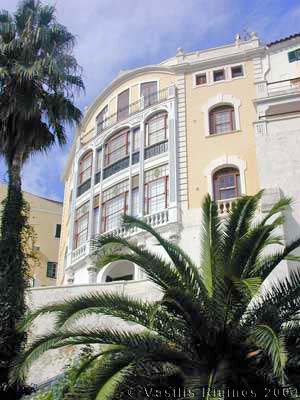
|
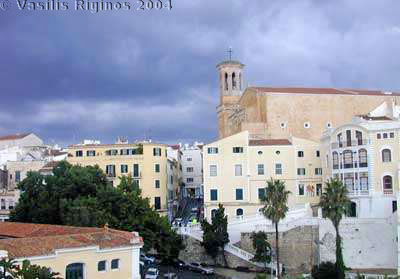
|
We then returned to the boat to realize that we had left, in what looked to be a sunny day, the hatch windows partly opened. The rain had gotten in and soaked many things inside the boat. Instead of a midday siesta we had to clean and sponge. Thank goodness a wonderful sun had emerged to help us. We did avoid, after all, the downpour that surrounded us as we were coming from Cagliari and it was a lot better to get it here than it in the middle of the night in the open sea.
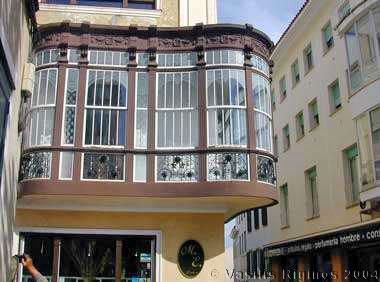
Later while Manos converted the eggplant that he had baked yesterday into a very tasty spread I cleaned the ugly black marks that the tire fenders had left on our stern during the squall in Cagliari. I also filled our water tanks.
After showers we walked back up the hill to Maó. I purchased a stainless steel pitcher to replace the fragile glass one which I have been using to make the afternoon filtered coffee. Manos had pointed out to me a few days ago that I do not have a replacement for this extremely vital system. Ever since I have been fretting and yesterday I almost dropped the glass pitcher. Now we have redundancy. We then looked in vain for an attractive restaurant. Not succeeding, we walked back down to the waterfront and ended up at the Yacht Club. We started with a tasty fish soup and then I “twisted” Manos’ arm into sharing a seafood paella with me along with a good white wine. By the time we walked back to Thetis it was past 11 PM.